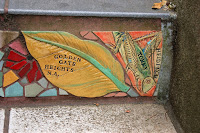This scary admonition is from Yale historian Timothy Snyder's
On Tyranny: Twenty Lessons from the Twentieth Century. Unhappily, I knew I'd be
coming back to his catalogue of warning signs of the death of the rule of law.
Charlottesville certainly brings this one to the fore. Here's more from Snyder:
It is impossible to carry out democratic elections, try cases at court, design and enforce laws, or indeed manage any of the other quiet business of government when agencies beyond the state also have access to violence. For just this reason, people and parties who wish to undermine democracy and the rule of law create and fund violent organizations that involve themselves in politics. Such groups can take the form of a paramilitary wing of a political party, the personal bodyguard of a particular politician— or apparently spontaneous citizens’ initiatives, which usually turn out to have been organized by a party or its leader. ...
... For violence to transform not just the atmosphere but also the system, the emotions of rallies and the ideology of exclusion have to be incorporated into the training of armed guards. These first challenge the police and military, then penetrate the police and military, and finally transform the police and military.
My emphasis. Certainly the white supremacist march in Charlottesville was well within the unhappy traditions of our country. And until the assault with car in the terrorist fashion of this season broke through the seeming ordinariness of tit for tat protest and counterprotest, the script had seemed predictable, if awful and frightening. Law enforcement
seemed to stand aloof from the back and forth. Nonetheless, a friend, a woman of color and an Episcopal priest, who was there reported:
The Unite The Right march was a joke. We watched it sputter down a street, take wrong turns, wilt in the heat. Their hate and fear are no joke. It was moving to witness the resistance: beautiful clergy and all kinds of counter protestors witness to love, beauty, and joy all over downtown Charlottesville.
And then someone was killed and so many injured. And it was no joke.
Vann Newkirk at the Atlantic draws a terrifying conclusion:
... even the most feared white supremacists in the lore of Jim Crow were just regular white men, transformed from lives as politicians, mechanics, farmers, and layabouts by the sheer power of ideology. And often, their movements were considered “fringe” and marginal—until they weren’t.
Where euphemism, newly-coined terms, and lack of historical perspective all leave the country confused as to just how the violence in Charlottesville came to be, the truth is there in plain sight. What happened there in Emancipation Park and what is happening not only in the streets of Charlottesville, but streets across the country, is that the rhetoric and policy of white supremacy, which is still fostered and abetted widely, is again being converted into the kinds of overt interpersonal violence by which most people recognize it. And for the people who stand to lose the most from that kind of violence, the question might be when—not if—it transforms from a political peripheral into a regime. ...
... The emerging lessons in Charlottesville are somber. White supremacy can and will flourish when given fuel; white-supremacist rhetoric will tend towards violence; and it’s often only in the rear-view mirror that Americans can clearly see the events that lead to that violence spreading. And although it is possible that the weekend’s tragedies and brutal confrontations in Charlottesville are one-offs -- the presence of antifa counter-protesters, who don’t themselves shy away from brawls, certainly makes this event distinct from Klan bombings and lynchings, for one -- America’s history suggests that vigilance is always in order.
The best the Orange Cheato had to offer was to call out violence "on many sides." It sure looked as if he'd provided the fuel.
Sometimes it takes [Louisiana white supremacist] David Duke to point out the obvious: “We’re going to fulfill the promises of Donald Trump.” Those and other, older promises as well.
Vincent Cunningham at the New Yorker
White supremacy is America's original sin and our permanent peculiar challenge to ideals of democracy, rule of law, justice and freedom. Our police and other agencies of state violence such as ICE's deportation agents always waver between enforcing law and enforcing white society's bigotry, becoming unalloyed agents of oppression.
Resistance includes all efforts to keep these forces from falling entirely into doing their and our rulers' worst. That means everything from legal challenges, encouraging law enforcement
professionalism where it exists, protests that seem small and futile when law enforcement is lawless, and taking the risk to witness and oppose where white supremacy seeks to claim public validation. All of that and more. Resist and protect much.











 Through no planning on our part, we happened into a leftist and nationalist fiesta in the Spanish (Basque) city of Bilbao on our way to hook up with the route of the Camino de Santiago. Not bad to happen into a feminist-themed street party!
Through no planning on our part, we happened into a leftist and nationalist fiesta in the Spanish (Basque) city of Bilbao on our way to hook up with the route of the Camino de Santiago. Not bad to happen into a feminist-themed street party!














































